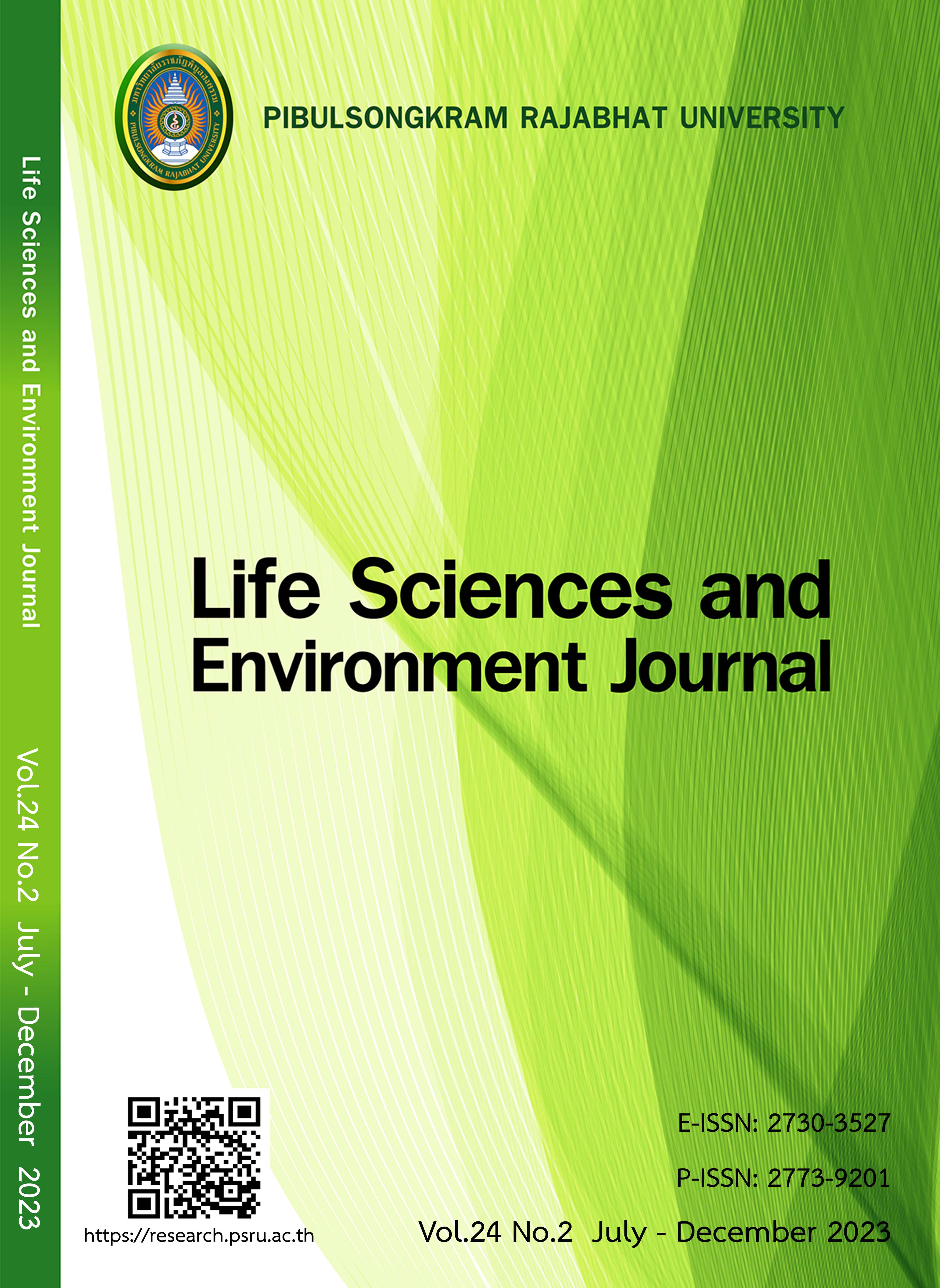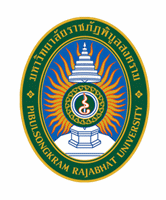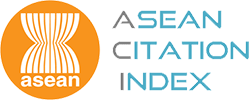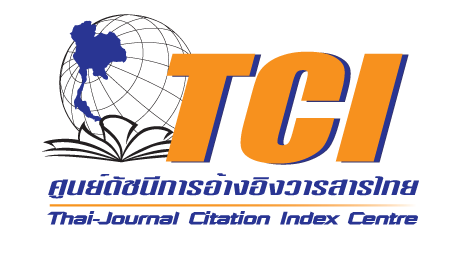EVALUATION OF HEAVY METAL CONTAMINATION IN WATER FOR PADDY FIELDS USAGE OF PHITSANULOK PROVINCE
DOI:
https://doi.org/10.14456/lsej.2023.24Keywords:
Irrigation water, Groundwater, Contamination, Heavy metal, Paddy fieldAbstract
The purpose of this research was to assess the heavy metal contaminations in water used for paddy cultivation in Phitsanulok Province. The total of 60 water samples were randomly collected from groundwater pumped to use in the paddy fields of 30 farmers and irrigation water pumped to use in the paddy fields of 30 farmers. Contaminations of lead, cadmium, copper, zinc, manganese and iron in water samples were analyzed by atomic absorption spectrometer. The results revealed that most of irrigation water used for paddy cultivation contaminated more heavy metal contents than the groundwater. The irrigation water was contaminated with the highest iron content, followed by manganese, zinc, lead, cadmium and copper with average values of 8.606±2.883, 0.662±0.516, 0.351±0.399, 0.097±0.085, 0.050±0.010 and 0.020±0.018 mg/L, respectively, which is considered to be within the Pollution Control Department's standard for agricultural use, but the average cadmium content exceeded the irrigation water standard for agriculture of Office of the Royal Development Projects Board (RDPB) and FAO. The groundwater pumped for paddy cultivation also had the highest iron contamination, followed by manganese, lead, zinc, copper and cadmium, with average values of 2.820±3.468, 0.816±0.932, 0.248±0.190, 0.142±0.239, 0.009±0.024 and 0.001±0.002 mg/L, respectively, which was not higher than the standard of RDPB and the groundwater standards for consumption of the Department of Groundwater Resources and NCAC, except for lead contamination.
References
Abdullah EJ, Hussain RF. Pollution evaluation of irrigation water in paddy fields at Al-Mishkhab area, Iraq. International Journal of Science and Research 2016;7(4):223-225.
Adesokan SA, Giwa ARA, Olu-Owolabi BI. Assessment of selected heavy metals in local rice, water and rice fields soil from Ibese Town, Ogun State, Nigeria. International Journal of Advanced Academic Research 2021;7(5):41-57.
Ayers RS, Westcot DW. Water quality for agriculture (FAO Irrigation and Drainage). Rome: Food and Agriculture Organization; 1985.
Boonpairose K. Contaminated of lead and cadmium in rice paddy field and ground water. Master of Engineering (Environmental Engineering), Faculty of Engineering, Ubon Ratchathani University; 2010.
Bureau of Groundwater Resources Region (Ratchaburi). Groundwater quality standards for consumption. Available at: http://www.dgr.go.th/bgr8/th/download/371. Accessed May 1, 2023.
Chaoua S, Boussaa S, El Gharmali A, Boumezzough A. Impact of irrigation with wastewater on accumulation of heavy metals in soil and crops in the region of Marrakech in Morocco. Journal of the Saudi Society of Agricultural Sciences 2019;18(4):429-36.
Chirasatienpon T, Sakulthaew C, Chokejaroenrat C, Techauay K, Sutjarit S, Sakulthaew C. Heavy metals contamination in ground water. Journal of Animal Health Science and Technology, 2019;3(2),16-23.
Chyad AA, Saeed AM, Alhendi AS. Determination of heavy metals inirrigation water, soil, paddy, and produced riceof some paddy fields of Iraq. Iraqi Journal of Science 2022;63(11):4637-4649.
Dissanayake CB, Chandrajith R. Phosphate mineral fertilizers, trace metals and human health. Journal of the National Science Foundation of Sri Lanka 2009;37(3):153–165.
Dissanayke DMPNK, De Silva SNT, Pathmarajah S, Fernando, CAN, Abeynayake, NR, Kodagoda, KADA, Dassanayake DMMNK. Occurrence of heavy metals in surface water bodies in rice cultivation areas in Trincomalee district, Sri Lanka. Paddy and Water Environment 2023;21(1):1-4.
Groundwater Analysis Division. Collection and preservation of water samples. Available at: http://www.dgr.go.th/skr/th/newsAll/243/3155. Accessed April 20, 2022.
Hindarwati Y, Soeprobowati TR. Heavy metal content in terraced rice fields at Sruwen Tengaran Semarang-Indonesia, 2018. In E3S Web of Conferences; EDP Sciences.
Kachenko AG, Singh B. Heavy Metals contamination in vegetables grown in urban and metal smelter contaminated sites in Australia. Water, air, and soil pollution 2006;169:101-123.
Khan S, Cao Q, Zheng YM, Huang YZ, Zhu YG. Health risks of heavy metals in contaminated soils and food crops irrigated with wastewater in Beijing, China. Environmental pollution 2008;152(3):686-692.
Kingsawat R, Roachanakanan R. Accumulation and distribution of some heavy metals in water, soil and rice fields along the Pradu and Phi Lok canals, Samut Songkhram province, Thailand. Environment and Natural Resources Journal 2011;9(1):38-48.
Muhammad S, Shah MT, Khan S. Health risk assessment of heavy metals and their source apportionment in drinking water of Kohistan region, northern Pakistan. Microchemical journal 2011;98(2):334-343.
National Bureau of Agriculture Commodity and Food Standards. Agreement on the Application of Sanitary and Phytosanitary Measures-SPS, 2015. Available at: http://www.spsthailand.net/general.php. Accessed January 22, 2023.
North Carolina Environmental Quality. Ground water quality standards. Available at: https://dep.nj. gov/wp-content/uploads/rules/rules/njac7_9c.pdf. Accessed April 1, 2023.
Nouri J, Mahvi AH, Jahed GR, Babaei AA. Regional distribution pattern of groundwater heavy metals resulting from agricultural activities. Environmental geology 2008;55:1337-1343.
Office of Agricultural Economics. Weekly production and marketing situation in 19-25 April 2021, 2021. Available at: https://www.oae.go.th/view/1/รายละเอียดสถานการณ์ผลิดและการตลาด/สถานการณ์การผลิตและการตลาดรายสัปดาห์ปี%202564/36583/TH-TH. Accessed May 11, 2023.
Office of the Royal Development Projects Board. Work manual: Indicators to develop water resources. Available at: https://www.rdpb.go.th/UploadNew/Documents/2b3ba478-298b-462c-aa41-bef4d8713b0c_6คู่มือ%20ตัวชี้วัดด้านการพัฒนาแหล่งน้ำ.pdf. Accessed April 1, 2023.
Perera PCT, Sundarabarathy TV, Sivananthawerl T, Kodithuwakku SP, Edirisinghe U. Arsenic and cadmium contamination in water, sediments and fish is a consequence of paddy cultivation: evidence of river pollution in Sri Lanka. Achievements in the Life Sciences 2016;10(2),144-160.
Phoket Y, Yooprasert B, Tangwiwat P. The extension of safety and standardized rice production adhering to good agricultural practice for farmers in Roi Et Province. Khon Kaen Agriculture Journal 2016; 44(1):624-629.
Pollution Control Department. Announcement of the national environment board on establishing quality standards for soil sediment in surface water sources, B.E. 2565 (2022). Available at: https://www.pcd.go.th/laws/28226. Accessed April 1, 2023.
Pollution Control Department. Report on the situation of water pollution from rice fields and management. Bangkok: Office of Water Quality Management; 2011.
Radwan MA, Salama AK. Market basket survey for some heavy metals in Egyptian fruits and vegetables. Food and chemical toxicology 2006;44(8):1273-1278.
Royal Initiative Project Support Group. Sampling technique/sampling procedure. Available at: http://www.dgr.go.th/skr/th/newsAll/243/3155. Accessed April 20, 2022.
The Office of Strategy Management: Lower Northern Provincial Cluster 1. Basic Information of the Lower Northern Region 1. Lower North Region Development Plan 1 (2018-2022), 2021. Available at: http://www.osmnorth-s1.moi.go.th/storage/roadmap/แผนพัฒนากลุ่มจังหวัดภาคเหนือตอนล่าง%201%20(พ.ศ.%202561%20-%202565)%20ฉบับทบทวน%20ปี%202564.pdf. Accessed December 11, 2022.
Thongkrua S. Water quality management for Thai jasmine rice agriculture in north Mekong basin area. Phayao: School of Energy and Environment, University of Phayao; 2020.
Downloads
Published
How to Cite
Issue
Section
License
Copyright (c) 2023 Life Sciences and Environment Journal

This work is licensed under a Creative Commons Attribution-NonCommercial-NoDerivatives 4.0 International License.
Each article is copyrighted © by its author(s) and is published under license from the author(s).









